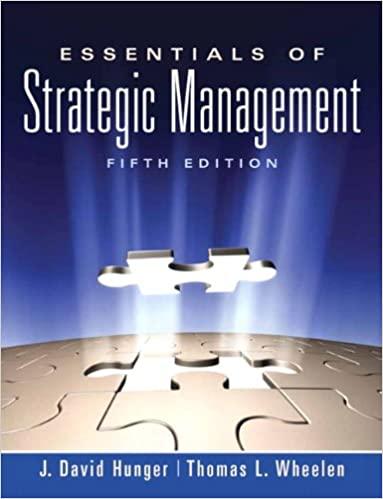Question
Cleaver's Sausage house Allison Elam, vice president of operations for Cleaver's Sausage House, a maker of fine sausages in Minnesota, was stunned. She felt numb.
Cleaver's Sausage house
Allison Elam, vice president of operations for Cleaver's Sausage House, a maker of fine sausages in Minnesota, was stunned. She felt numb. Just 30 minutes ago, she had been happy and excited about the upcoming meeting, which would decide whether to launch the new material requirements planning (MRP) software system that her department had been planning. Now the meeting was over, and Cleaver's executive committee had not agreed to launch the system.
She thought the go/no-go decision would be just a formality. But David Martin, CFO, expressed a doubt about implementing the system, and things went downhill from there."I so thought he was on board," Elam hissed to herself. Other senior staff then pushed back hard. They warned that the change could be a costly disaster. The vice president of sales doubted whether the MRP system could provide the solid sales forecasts that Cleaver needed. He called MRP "just big corporate BS." He also feared it would result in shortages of raw materials. The director of logistics, Susan Frisch, warned about problems that had erupted at one of her previous employers when a similar system was installed. She related a horror story about customers not getting orders and trucks leaving the plant half-full. Her final comment was,"We are successful. Why upset the apple cart?
Cleaver CEO Jayden Anderson had hired Elam to take the position vacated by his ailing brother Stefan, who died in late 2015. Elam has been on the job for ten months, spending much of her time working alone on the MRP project. Stefan had purchased the MRP software prior to his illness, but it had sat unused since then. Elam sometimes wondered if Stefan would have had an easier time with implementation had he lived to see the project through. Elam was a veteran of big companies such as Heinz and Coca-Cola, and Anderson wanted an outsider like her to bring in new technology to help operations get to the next level. Elam had worked with successful MRP systems in the past, and she had assured Anderson that the new system would overhaul procurement, production, and shipping and would impose much-needed discipline on operations. She estimated that the system would increase annual cash flow by $600,000 and save up to $200,000 annually by reducing waste. This was serious money for a company with only 350 employees.
Elam wondered if the real problem was that implementing the MRP idea would require a radical overhaul of every facet of Cleaver's operations. Making the system work would require at least 25 Cleaver managers and employees to change how they did their jobs. Still angry, Elam thought,"What are the VPs and department heads so scared of?"
Prior to the executive committee meeting, Elam had encountered plenty of obstacles. She was unable to get data from several people to create a mock-up of how the system would work. Some key managers or their direct reports came late to the first and second meetings or simply skipped them, and she had complained to the CEO about the lack of cooperation. It was obvious to Elam that the topic was not a priority for the other VPs and department heads. Anderson's response was to suggest forming a cross-departmental task force to help her. Elam told him, "I believe in this technology, and I will get it done. A task force will just slow me down."
Allison Elam was a pleasant, reserved individual who did not like conflict. She had been mentally unprepared for the executive committee's no-go decision, and she shuddered at the thought that the MRP system might not be adopted at all. She decided to sleep on it for a night or two and then plan a course of action to get this system implemented, both for Cleaver's benefit and for her own conscience.
Questions
1. What do you think are the reasons for people's resistance to the MRP implementation? Explain.
2. What is the value of the task force idea suggested by the CEO as a way to facilitate implementation? Explain.
3. Which implementation tactics do you think Elam should follow? Why?
Note: a credible source in-text citation and reference in APA
Step by Step Solution
There are 3 Steps involved in it
Step: 1

Get Instant Access to Expert-Tailored Solutions
See step-by-step solutions with expert insights and AI powered tools for academic success
Step: 2

Step: 3

Ace Your Homework with AI
Get the answers you need in no time with our AI-driven, step-by-step assistance
Get Started


